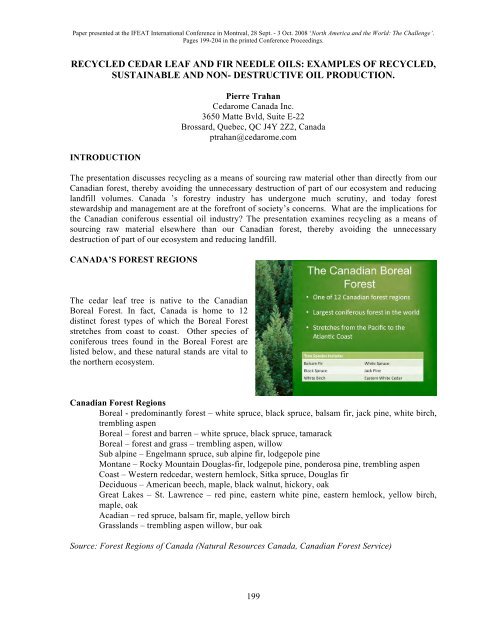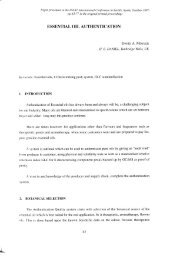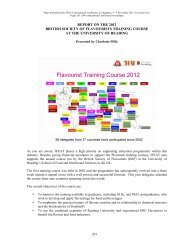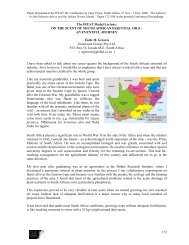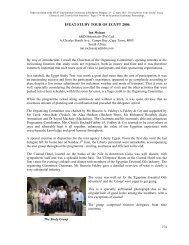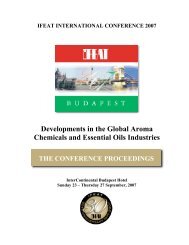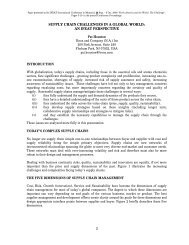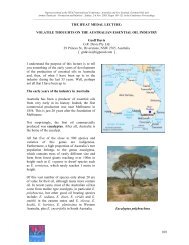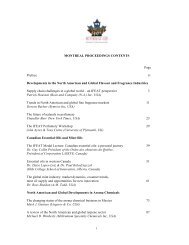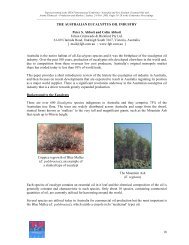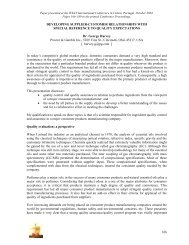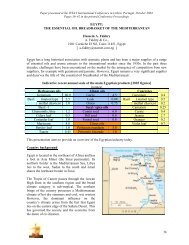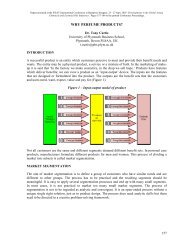Create successful ePaper yourself
Turn your PDF publications into a flip-book with our unique Google optimized e-Paper software.
Paper presented at the <strong>IFEAT</strong> International Conference in Montreal, 28 Sept. - 3 Oct. 2008 ‘North America and the World: The Challenge’.Pages 199-204 in the printed Conference Proceedings.RECYCLED CEDAR LEAF AND FIR NEEDLE OILS: EXAMPLES OF RECYCLED,SUSTAINABLE AND NON- DESTRUCTIVE OIL PRODUCTION.INTRODUCTIONPierre <strong>Trahan</strong><strong>Cedar</strong>ome Canada Inc.3650 Matte Bvld, Suite E-22Brossard, Quebec, QC J4Y 2Z2, Canadaptrahan@cedarome.comThe presentation discusses recycling as a means of sourcing raw material other than directly from ourCanadian forest, thereby avoiding the unnecessary destruction of part of our ecosystem and reducinglandfill volumes. Canada ’s forestry industry has undergone much scrutiny, and today foreststewardship and management are at the forefront of society’s concerns. What are the implications forthe Canadian coniferous essential oil industry? The presentation examines recycling as a means ofsourcing raw material elsewhere than our Canadian forest, thereby avoiding the unnecessarydestruction of part of our ecosystem and reducing landfill.CANADA’S FOREST REGIONSThe cedar <strong>leaf</strong> tree is native to the CanadianBoreal Forest. In fact, Canada is home to 12distinct forest types of which the Boreal Foreststretches from coast to coast. Other species ofconiferous trees found in the Boreal Forest arelisted below, and these natural stands are vital tothe northern ecosystem.Canadian Forest RegionsBoreal - predominantly forest – white spruce, black spruce, balsam fir, jack pine, white birch,trembling aspenBoreal – forest and barren – white spruce, black spruce, tamarackBoreal – forest and grass – trembling aspen, willowSub alpine – Engelmann spruce, sub alpine fir, lodgepole pineMontane – Rocky Mountain Douglas-fir, lodgepole pine, ponderosa pine, trembling aspenCoast – Western redcedar, western hemlock, Sitka spruce, Douglas firDeciduous – American beech, maple, black walnut, hickory, oakGreat Lakes – St. Lawrence – red pine, eastern white pine, eastern hemlock, yellow birch,maple, oakAcadian – red spruce, balsam fir, maple, yellow birchGrasslands – trembling aspen willow, bur oakSource: Forest Regions of Canada (Natural Resources Canada, Canadian Forest Service)199
of the high water content in the leaves. Temperature also dictates the yields of the cedar <strong>leaf</strong>extraction process. The best weather for trimming cedar <strong>leaf</strong> is during warm days and cool nights.There is a 30 to 50 percent difference inextraction yields between cultivated and wildleaves: 0.60% to 0.75% for cultivated cedar, andonly 0.40% to 0.50% for wild cedar. Other thanthe crowded growing conditions in the wild, thedifference in yield is due to the great care givento ornamental hedges in most gardens. <strong>Cedar</strong>hedges are by far the most popular type ofvegetation used by Canadian homeowners as aproperty border or privacy screen.The Outaouais region, part of the cedar belt of Canada, is home to an innovative entrepreneur whocombined his love of nature and business talent to become a pioneer in the field of producing essentialoil from recycled material in Canada. He has successfully turned what would otherwise have beenwaste into a sustainable supply of quality rawmaterial. After 15 years of operation, Recycled<strong>Cedar</strong> of Outaouais receives an average of 200calls from gardeners for cedar <strong>leaf</strong> clipping pickupa day. A carefully dispatched group of trucksand a well-planned production facility ensuretimely pick-up and processing of leaves.Each year over 2,000 tons of cedar <strong>leaf</strong> isextracted at this facility. These 2,000 tonsrepresents 50% of all the cedar trimmings in theregion. Of these 2,000 tons, 80-85% are from thesame hedges year after year.The harvesting season follows the maintenance needs of these ornamental shrubs and screens.Homeowners usually trim their hedges in late June - early July to stimulate growth and thereforeincrease the fullness of the tree; and/or mid August until October to prepare their hedges for thewinter.Trimmings destined for extraction are often picked up and processed the same day or within 24 hoursof trimming. Great care is also taken not to let the leaves dry out in transport to the extraction facilityby tightly covering the load.202
Gardeners are glad to cooperate and gather theirtrimming for pick-up and thereby participate in arecycling venture. They are invited to pick upfree of charge the “oil freed” dregs of theextraction process, which makes very goodmulch. Surplus dregs are also sold to gardencenters. Mulch is an organic fertilizer used bymany gardeners to enrich their soil. <strong>Cedar</strong> <strong>leaf</strong>mulch also acts as a natural repellent to controlinsects, a thermal shield to keep soil cool andmoist, as well as a physical barrier limiting thegrowth of weeds.Thanks to the services provided by Recycled<strong>Cedar</strong> of Outaouais, the municipalities it serves save $61- $86 per ton of leaves that would otherwisehave ended up in the landfill or an estimated $122,000 -$172,000 a year in garbage pick-up fees, not tomention the savings associated with the unused area in the landfill.FIR NEEDLE OILAnother noteworthy example of recycling isBalsam Fir. The raw material used in theextraction of Balsam fir needle oil is alsoincreasingly sourced elsewhere than in theCanadian Boreal forest. Balsam Fir trees arecultivated not only for use in landscaping butmostly to be cut and sold as Christmas trees bothin Canada and exported in even greater numbersto the nearby large American market. Fir needlebranches that are produced in the cutting of treesfor the lumber and firewood industries areanother source of raw material for distillation.The branches constitute a byproduct that would otherwise be wasted. Tree trimmings generated fromthe shaping of these cultivated trees, irregular trees that do not meet market requirements, and unsoldtrees at the end of the holiday season are other sources of raw material for the production of Canadianfir needle oil. Municipal curbside collection ofChristmas trees after the holidays provides aportion of the raw material needed for theproduction of fir needle oil and reduces landfill.Fir needle oil is used not only in pharmaceuticals,cosmetics, personal care and fine and householdfragrances but also increasingly in creative flavorapplications. Fir needle oil, like many otherconiferous oils such as spruce, is non-toxic. InQuébec, spruce beer is a local specialty madefrom a fermented mixture, which also includesroots, bark and molasses.203
CONCLUSIONBy sourcing raw materials elsewhere than from our Canadian forests we avoid the unnecessarydestruction of our northern ecosystem including our wildlife’s natural habitat, and contribute toreducing landfill.Finally, in preparing this presentation I would especially like to thank Robert Marcotte of Recycled<strong>Cedar</strong> of Outaouais, Bill Brown of Dominion Essential Oils and Yves Boisvert of <strong>Cedar</strong>ome CanadaInc.Pierre <strong>Trahan</strong> has worked in the flavours and fragrance industry for over 30years. He began his career at Bush Boake Allan and in 1984 created <strong>Cedar</strong>omeCanada Inc., where he is now President. A lawyer by training, Mr. <strong>Trahan</strong> hasbecome well regarded for his citrus and coniferous expertise. His contributionsto the flavour and fragrance industry include the support and development ofCanada’s indigenous products.204


